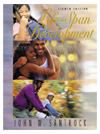 |  Life-Span Development, 8/e John W. Santrock,
University of Texas - Dallas
Infancy Physical Development in Infancy
Chapter ObjectivesI.Distinguish between cephalocaudal and proximodistal growth patterns. |
 |  |  | II.Describe the physical changes during the first 2 years, including those in height and weight, and changes in brain organization and structure. |
 |  |  | III.Describe each of the eight categories of infant states, then define REM sleep and explain its purpose. |
 |  |  | IV.Describe sudden infant death syndrome (SIDS), and list its risk factors. |
 |  |  | V.Discuss the array of nutritional needs for the infant, including the pros and cons of breast- versus bottle-feeding and findings about infant malnutrition. |
 |  |  | VI.Summarize the arguments surrounding the question of when to toilet train. |
 |  |  | VII.Describe the various infant reflexes and explain their importance. |
 |  |  | VIII.Explain how the development of gross motor skills and fine motor skills follow the principles of cephalocaudal and proximodistal sequences. |
 |  |  | IX.State how developmental biodynamics explains how motor behaviors are assembled for perceiving and acting. |
 |  |  | X.Differentiate between sensation and perception. |
 |  |  | XI.Describe the infant's visual abilities, including visual acuity, color vision, visual preferences, depth perception, and visual expectations. |
 |  |  | XII.Describe the infant's senses in addition to vision, explaining how we know that infants can hear before birth and identifying odors and tastes that newborns can discriminate. |
 |  |  | XIII.Define intermodal perception and the notion of perceptual-motor coupling and unification. |
|



 2002 McGraw-Hill Higher Education
2002 McGraw-Hill Higher Education